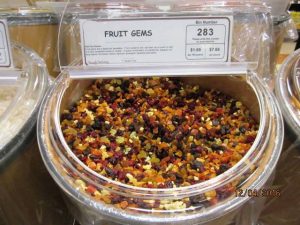Candied and glacé fruits have a place in food history to remind us of the days that a grocery store was not just around the corner. One of the Christmas gifts that my grandmother cherished getting was candied peel (not something that I ever developed a taste for). The typical fruit in fruitcakes is known as glacé fruit or peel. Candied fruit, glacé fruit also known as crystallized fruit, or fruits confits (French for cooking in a water syrup at a low temperature) were common ingredients or sweet treats at the turn of the 20th century.
(Photos courtesy Simply Delicious, Vernon, BC)
The basic process for making candied fruit has been around since the 14th century when sugar became more widely available . It involves placing whole fruit, smaller pieces of fruit, or pieces of peel, in heated sugar syrup, which absorbs the moisture from within the fruit and eventually preserves it. It is a bit more sophisticated than the ancient Roman process of just placing fruit in honey but both use the same scientific principle of osmosis, which we might remember from our high school science. It’s “the spontaneous net movement of solvent molecules through a semi-permeable membrane into a region of higher solute concentration, in the direction that tends to equalize the solute concentrations on the two sides”. In other words the syrup must have a higher density than the liquid contained in the cells of the fruit so that the penetration of the sugars actually takes place. Glacé fruit or peel is fruit that is drained from the sugar syrup and used as is for eating or baking, whereas candied or crystallized fruit is air dried and then coated with sugar.
The home cook typically does this by boiling the fruit or peel in a high sugar/water solution until the fruit is clear or the peel is transparent. These two processes from Canadian Living are very similar to those I have found in old cookbooks:
For Candied Glacé Fruit
- Cut your chosen fruit into 1/4-inch (5 mm) slices.
2. For every 1/2 cup of sugar, combine with 1-1/2 cups of water in a saucepan. Bring to a boil.
3. Add your sliced fruit into the boiling sugar syrup, keeping the fruit covered by syrup. Cook at medium-low heat, turning the slices of fruit occasionally, for 40 to 50 minutes or until the fruit becomes translucent, but still intact.
4. Use a slotted spoon to transfer the sliced fruit onto a wire rack. Let cool and dry overnight.
5. Roll sliced fruit in a layer of sugar to complete your candied treat. Store in an airtight container, between sheets of waxed paper, in the fridge or a cool, dry place for up to six months.
For Candied Glacé Peel
Cut your chosen citrus fruit into quarters. Cut off the peel, but leave a thin layer of the pith attached. Cut into 1/2-inch (1 cm) strips.
• Blanch the peels three times. Cover the citrus peels with fresh water each time, and bring to a boil for one minute.
• Using the same sugar to water ratio as above (1:3), simmer your blanched peels over low heat for 45 to 60 minutes, or until translucent.
• Remove citrus peels from syrup, transfer to wire rack to cool, then coat in sugar.
If you are going to use the fruit or peel in recipes, then remove them from the syrup and skip the final step of coating them with sugar. They will be sticky to the touch but are ideal for baking and decorating cakes.
The commercial process follows a similar process but often is much longer involving soaking the fruit in successively greater concentrations of sugar to intensify the color and flavor by gradually replacing the juices contained in the fruit cells with a sugar syrup so that this preservation process prevents fermentation or spoilage by bacteria. A number of canneries in the Okanagan made glacéd fruit from local fruit. According to Jones (2012) the Stowell Canning Company in Oliver that operated from 1936 to 1960 processed candied fruit and glacé cherries. The L. Deighton cannery established in 1938 in Oliver processed candied fruit as well.
Years ago an elderly neighbor told me she made all the fruit for her Christmas baking from zucchini. I never quizzed her about the process and now I wish I had. I assume that the recipe came about as a cost saving measure probably in the depression era. I went on a search for mock candied or glacé fruit made from zucchini in my limited supply of old cookbooks but had no luck. An internet search turned up some interesting variations. One from www.food.com takes three days and uses Kool-Aid powdered drink mix for colouring, another from www.cooks.com uses pineapple juice to make mock candied pineapple. The recipe from www.traditional-foods.com doesn’t try to disguise the source, it just makes candied zucchini.
In the Edith Adam’s Twelfth Annual Prize Cook Book from 1948 I found a recipe for Imitation Preserved Ginger using lettuce stalks:
When lettuce has run to seed, peel the stalks and cut into pieces, 2 to 3 inches long. Cover with cold water and bring to a good boil. Remove stalks from pan, lay on a soft clean cloth to drain. Boil 2 pounds of preserving sugar in a pint of water until it threads very slightly. Flavor well with lemon peel and ginger. When really hot and lemony, place the stalks in a dish and pour the syrup over them. Leave for 12 hours, covered. Then boil up again. Do this 6 times, put in small pots and seal.
Whether it is the real thing or an imitation version, whether it is for baking or a candy treat, whether it is home made or a commercial preparation, glacé or candied fruits are historical preserves that tell stories of the history of sugar and preservation, the ingenuity of cooks, and family life.
I’d be interested in hearing from our BC Food History readers if any of their cookbooks have recipes.
References
Jones, V. P. (2010). Historical narrative of the canning industry in British Columbia’s southern interior. Retrieved from http://hdl.handle.net/2429/30686
http://www.canadianliving.com/food/cooking-school/article/how-to-make-candied-fruit
http://www.cooks.com/recipe/v90m96nd/mock-pineapple-from-zucchini.html
http://www.food.com/recipe/glazed-fruit-zucchini-111697
http://www.traditional-foods.com/recipes/candied-zucchini/



Leave A Comment